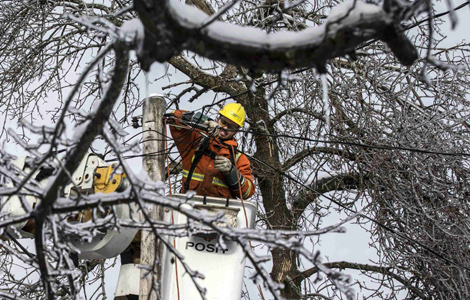Li drops in to help realize home dream
Updated: 2013-12-28 00:42
By ZHAO YINAN in Tianjin and XU WEI in Beijing (China Daily)
|
||||||||
For Li Zongyi, 77, an unexpected visitor to her home has realized her decades-long dream.
The guest was Premier Li Keqiang. During a one-day trip to Tianjin on Friday, he paid a surprising visit to Li Zongyi's home in the Xiyuzhuang community, one of the oldest shantytowns in the city, and promised residents that they will be able to move into new apartments in the next year.
Han Huixia, Li Zongyi's daughter, said: "I have been waiting for this moment for so long. I dare not burn coal to keep warm in winter, in case there is a gas leak or a fire."
Like families in the Xiyuzhuang community, hundreds of millions of residents in shantytowns nationwide are expected to move into new apartments, analysts said, as the country pushes ahead with renovation projects for these areas.
Huang Xiaohu, a researcher at a consultancy center affiliated to the Ministry of Land and Resources, said the renovation of some shanty areas can be very difficult, due to the complexity of the local population, a lack of financial support, and disagreements among residents on the relocation plan.
The Xiyuzhuang community, covering 64 hectares and with low-income residents comprising 20 percent of its households, is a typical case, Huang said, as the cost of compensation is too high.
"The only way out in this case is to let the government play the dominant role and provide residents with low-cost houses, instead of costly commercial apartments," he said.
A State Council meeting in June pledged to improve housing conditions for the underprivileged and to promote urbanization by accelerating shantytown reform.
Urbanization will also be pushed for another 100 million people living in the country's less developed western areas.
To achieve the target, the government will encourage private capital and enterprises to invest in the shantytown transformation, and will allow local authorities to use corporate bonds to solve the financing problem.
As of 2013, China has solved the housing problems of 2.18 million households living in shantytown areas and embarked on projects that could solve such problems for another 3.23 million households, 6 percent higher than planned.
Tao Ran, a professor at Renmin University of China, said the government has looked to the resettlement of residents in shanty areas to be one of its key economic drives in coming years.
But some fundamental work should be addressed before any steps are taken, he said.
Tao suggested that a universal guideline be introduced for local governments to follow during demolition of homes to avoid misconduct and conflicts.
Contact the writer at zhaoyinan@chinadaily.com.cn

 Ice storm leaves many without power in US, Canada
Ice storm leaves many without power in US, Canada
 Abe's war shrine visit sparks protest
Abe's war shrine visit sparks protest
 LeBron James is AP's Male Athlete of the Year
LeBron James is AP's Male Athlete of the Year
 Year-end horse-ride parade California
Year-end horse-ride parade California
 Pick your new year sunrise
Pick your new year sunrise
 Memorial a big draw on Mao's birthday
Memorial a big draw on Mao's birthday
 China's urbanization rate to hit 60% by 2018
China's urbanization rate to hit 60% by 2018
 Oly champion resumes training after scandal
Oly champion resumes training after scandal
Most Viewed
Editor's Picks

|

|

|

|

|

|
Today's Top News
China reports 12th vaccine-related death
China begins e-commerce legislation
Li drops in to help realize home dream
Govt issues holiday warning
US judge upholds NSA surveillance program
War shrine visit fury mounts
China's vaccines are safe: WHO
Chinese students in US buy luxury
US Weekly

|

|






